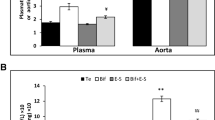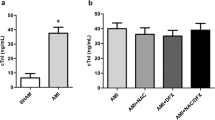Abstract
Cardiovascular effects of chronic AZT treatment on SD male rats (185 g) fed either a normal Mg diet (0.1% MgO) or a high Mg diet (0.6% MgO) were examined. AZT treatment (1 mg/ml drinking water) for 3 weeks led to a 5.5-fold (0.88 ± 0.11 nmol/min/106 cells, P < 0.05) elevation in neutrophil basal activity of O2 − production versus controls (0.16 ± 0.03 nmol/min, assayed ex vivo as SOD-inhibitable cytochrome c reduction). Concomitantly, plasma 8-isoprostane and PGE2 levels rose 2.1-fold and 3-fold (both P < 0.05), respectively, compared to control; however, RBC GSH decreased 28% (P < 0.02) with GSSG content increased 3-fold, indicative of systemic oxidative stress. High Mg diet substantially attenuated the AZT-induced neutrophil activation by 70% (0.26 ± 0.05 nmol/min, P < 0.05); reduced plasma 8-isoprostane and PGE2 to levels comparable to normal; and RBC GSH was restored back to 92% of control. AZT alone caused moderate, but significant vascular inflammatory lesions in the heart (assessed by H&E staining). Immunohistochemical staining revealed significantly higher (about 4-fold) infiltration of CD11b positive cells (WBC surface marker) in the atria and ventricles of AZT-treated rats. However, these inflammatory pathological markers were minimal in samples of rats treated with AZT plus high Mg diet. Moreover, AZT alone significantly (P < 0.02) decreased rat weight gain by 21% at 3 weeks; Mg-supplementation completely prevented (P < 0.05) the weight gain loss due to AZT intake. It is concluded that high dietary Mg may provide beneficial effects against AZT toxicity due to its systemic antioxidative/anti-inflammatory properties.





Similar content being viewed by others
References
Schroder, J. M., Bertram, M., Schnabel, R., & Pfaff, U. (1992). Nuclear and mitochondrial changes of muscle fibers in AIDS after treatment with high doses of zidovudine. Acta Neuropathologica, 85, 39–47. doi:10.1007/BF00304632.
Lewis, W., Copeland, W. C., & Day, B. J. (1998). DNA depletion, oxidative stress and mutation: Mechanisms of dysfunction from NRTIs. Laboratory Investigation, 81, 777–790.
Komarov, A. M., Hall, J. M., & Weglicki, W. B. (2004). Azidothymidine promotes free radical generation by activated macrophages and hydrogen peroxide-iron-mediated oxidation in a cell-free system. Biochimica et Biophysica Acta, 1688, 257–264.
Lewis, W., Gozalex, B., Chomyn, A., & Papoian, T. (1992). Zidovudine induces molecular biochemical and ultrastructural changes in rat skeletal muscle mitochondria. The Journal of Clinical Investigation, 89, 1354–1360. doi:10.1172/JCI115722.
Lamperth, L., Dalakas, M. C., Dagani, F., Anderson, J., & Ferrari, R. (1991). Abnormal skeletal and cardiac muscle mitochondria induced by zidovudine. Laboratory Investigation, 65, 742–751.
Arnaudo, E., Dalakas, M. C., Shanske, S., Moraes, C. T., Dimauro, S., & Schon, E. A. (1991). Depletion of muscle mitochondrial DNA in AIDS with zidovudine-induced myopathy. Lancet, 337, 508–510. doi:10.1016/0140-6736(91)91294-5.
Dalakas, M., Illa, Y., Peseshkpour, G. H., Laukatis, J. P., Cohen, B., & Griffin, J. L. (1990). Mitochondrial myopathy caused by long-term zidovudine therapy. The New England Journal of Medicine, 322, 1098–1105.
Szabados, E., Fischer, G., Toth, K., Csete, B., Nemeti, B., Trombitas, K., et al. (1999). Role of reactive oxygen species and poly-ADP-ribose polymerase in the development of AZT-induced Cardiomyopathy in rats. Free Radical Biology and Medicine, 26, 309–317. doi:10.1016/S0891-5849(98)00199-3.
De la Asuncion, J. G., del Olmo, M. L., Sastre, J., Millan, A., Pellin, A., Pallardo, F. V., et al. (1998). AZT treatment induces molecular and ultrastructural oxidative damage to muscle mitochondria. Prevention by antioxidant vitamins. The Journal of Clinical Investigation, 102, 4–9. doi:10.1172/JCI1418.
Sutliff, R. L., Dikalov, S., Weiss, D., Parker, J., Raidel, S., Racine, A. K., et al. (2002). Nucleoside reverse transcriptase inhibitors impair endothelium-dependent relaxation by increasing superoxide. The American Journal of Physiology, 283(6), H2363–H2370.
Wang, Y., & Watson, R. R. (1993). Is vitamin E supplementation a useful agent in AIDS therapy? Progress in Food & Nutrition Science, 17, 351–375.
Soltani, N., Keshavarz, M., & Minaii, B. (2005). Effects of oral Mg on plasma glucose and pathological changes in the aortic and pancreas of diabetic rats. Clinical and Experimental Pharmacology and Physiology, 32, 604–610. doi:10.1111/j.0305-1870.2005.04238.x.
Asai, T., Nakatani, T., & Yamanka, S. (2002). Mg supplementation prevents experimental chronic cyclosporine nephrotoxicity. Transplantation, 74, 784–791. doi:10.1097/00007890-200209270-00009.
Altura, B. T., Brust, M., Bloom, S., Barbour, R. L., Stempak, J. G., & Altura, B. M. (1990). Magnesium dietary intake modulates blood lipid levels and atherogenesis. Proceedings of the National Academy of Sciences of the United States of America, 87, 1840–1844. doi: 10.1073/pnas.87.5.1840.
Mak, I. T., Goldfarb, M. G., Weglicki, W. B., & Haudenschild, C. C. (2004). Cardiac pathologic effects of AZT in Mg-deficent mice. Cardiovascular Toxicology, 4, 169–178. doi:10.1385/CT:4:2:169.
Mak, I. T., Kramer, J. H., Chmielinska, J. J., Khalid, M. H., Landgraf, K. M., & Weglicki, W. B. (2008). Inhibition of neutral endopeptidase potentiates neutrophil activation during Mg-deficiency in the rat. Inflammation Research, 57, 300–305. doi:10.1007/s00011-007-7186-z.
Mak, I. T., Stafford, R. E., & Weglicki, W. B. (1994). Loss of red cell glutathione during Mg deficiency: Prevention by vitamin E, D-propranolol, and chloroquine. The American Journal of Physiology, 267, C1366–C1370.
Mak, I. T., Komarov, A. M., Wagner, T. L., Stafford, R. E., Dickens, B. F., & Weglicki, W. B. (1996). Enhanced NO production during Mg deficiency and its role in mediating red blood cell glutathione loss. The American Journal of Physiology, 271, C385–C390.
Mak, I. T., Kramer, J. H., & Weglicki, W. B. (2003). Suppression of neutrophil and endothelial activation by substance P receptor blockade in the Mg-deficient rat. Magnesium Research, 16, 91–97.
Chmielinska, J. J., Tejero-Taldo, M. I., Mak, I. T., & Weglicki, W. B. (2005). Intestinal and cardiac inflammatory response shows enhanced endotoxin receptor (CD14) expression in magnesium deficiency. Molecular and Cellular Biochemistry, 278, 53–57. doi:10.1007/s11010-005-2733-9.
Morrow, J. D., Frei, B., Longmire, A. W., Gaziano, J. M., Lynch, S. M., Shyr, Y., et al. (1995). Increase in circulating products of lipid peroxidation (F2-isoprostanes) in smokers. Smoking as a cause of oxidative damage. The New England Journal of Medicine, 332, 1198–1203. doi:10.1056/NEJM199505043321804.
Lund, K. C., & Wallace, K. B. (2008). Adenosine 3′5′-cAMP-dependent phosphoregulation of mitochondrial complex I is inhibited by nucleoside reverse transcriptase inhibitors. Toxicology and Applied Pharmacology, 226, 94–106. doi:10.1016/j.taap.2007.08.015.
Lund, K. C., Peterson, L. L., & Wallace, K. B. (2007). Absence of a universal mechanism of mitochondrial toxicity by nucleoside analogs. Antimicrobial Agents and Chemotherapy, 51, 2531–2539. doi:10.1128/AAC.00039-07.
Brechard, S., & Tschirhart, E. J. (2008). Regulation of superoxide production in neutrophils: Role of calcium influx. Journal of Leukocyte Biology, 84, 1223–1237. doi:10.1189/jlb.0807553.
Kurihara, H., Murayama, Y., Warbington, M. L., Champagne, C. M. E., & Van Dyke, T. E. (1993). Calcium-dependent protein kinase C activity of neutrophils in localized juvenile periodonitis. Infection and Immunity, 61, 3137–3142.
Entman, M. L., Youker, K., Shoji, T., Kukielka, G., Shappell, S. B., Taylor, A. A., et al. (1992). Neutrophil induced oxidative injury of cardiac myocytes: A compartmented system requiring CD11b/CD18-ICAM-1 adherence. The Journal of Clinical Investigation, 90, 1335–1345. doi:10.1172/JCI115999.
Shechter, M. (2003). Does magnesium have a role in the treatment of patients with coronary artery disease. American Journal of Cardiovascular Drugs, 3, 231–239. doi:10.2165/00129784-200303040-00001.
Murthi, S. B., Wise, R. M., Weglicki, W. B., Komarov, A. M., & Kramer, J. H. (2003). Mg-gluconate provides superior protection against postischemic dysfunction and oxidative injury compared to Mg-sulfate. Molecular and Cellular Biochemistry, 245, 141–148. doi:10.1023/A:1022840704157.
Kawano, Y., Matsuoka, H., Takishita, S., & Omae, T. (1998). Effects of magnesium supplementation in hypertensive patients. Hypertension, 32, 260–265.
Touyz, R. M., & Milne, F. J. (1999). Magnesium supplementation attenuates, but not prevents, development of hypertension in spontaneously hypertensive rats. American Journal of Hypertension, 12, 757–765. doi:10.1016/S0895-7061(99)00064-3.
Papparella, I., Ceolotto, G., Berto, L., Cavalli, M., et al. (2007). Vitamin C prevents zidovudine-induced NADPH oxidase activation and hypertension in the rat. Cardiovascular Research, 73, 432–438. doi:10.1016/j.cardiores.2006.10.010.
Altura, B. T., & Altura, B. M. (1981). Role of magnesium ions in contractility of blood vessels and skeletal muscles. Magnesium Bulletin, 3, 102–106.
Asai, T., Nakatani, T., Yamanaka, S., Tamada, S., Kishimoto, T., Tashiro, K., et al. (2002). Magnesium supplementation prevents experimental chronic cyclosporine a nephrotoxicity via rennin-angiotensin-system independent mechanism. Tansplantation, 74, 754–755. doi:10.1097/00007890-200209270-00002.
Choudlary, S., Kumar, A., Kale, R. K., Raisz, L. G., & Pilbeam, C. C. (2004). Extracellular calcium induces COX-2 in osteoblasts via a PKA pathway. Biochemical and Biophysical Research Communications, 322, 395–402. doi:10.1016/j.bbrc.2004.07.129.
Mak, I. T., Nedelec, L. F., & Weglicki, W. B. (2004). Pro-oxidant properties and cytotoxicity of AZT-monophosphate and AZT. Cardiovascular Toxicology, 4, 109–115. doi:10.1385/CT:4:2:109.
Pollack, S., & Weaver, J. (1993). AZT-induced siderosis. American Journal of Hematology, 43, 230–233. doi:10.1002/ajh.2830430314.
Kramer, J. H., Dadgar, S., Hall, J., Mak, I. T., & Weglicki, W. B. (2004). Rat tissue iron content is differentially altered by AZT and Mg-deficiency. Journal of Molecular and Cellular Cardiology, 36, 631. Abs.
Bogden, J. D., Baker, H., Frank, O., Perez, G., Kemp, F., Bruening, K., et al. (1990). Micronutrient status and human immunodeficiency virus (HIV) infection. Annals of the New York Academy of Sciences, 587, 189–195.
Savarino, A., Pescarmona, G. P., & Boelaert, J. R. (1999). Iron metabolism and HIV infection: Reciprocal interactions with potentially harmful consequences? Cell Biochemistry and Function, 17, 279–287. doi:10.1002/(SICI)1099-0844(199912)17:4<279::AID-CBF833>3.0.CO;2-J.
Acknowledgments
The authors wish to thank Kenny Landgraf for his excellent technical assistance. This study was supported by NIH R21-AT003993 & NIH RO1-HL-65178.
Author information
Authors and Affiliations
Corresponding author
Rights and permissions
About this article
Cite this article
Mak, I.T., Chmielinska, J.J., Kramer, J.H. et al. AZT-Induced Oxidative Cardiovascular Toxicity: Attenuation by Mg-Supplementation. Cardiovasc Toxicol 9, 78–85 (2009). https://doi.org/10.1007/s12012-009-9040-8
Received:
Accepted:
Published:
Issue Date:
DOI: https://doi.org/10.1007/s12012-009-9040-8




